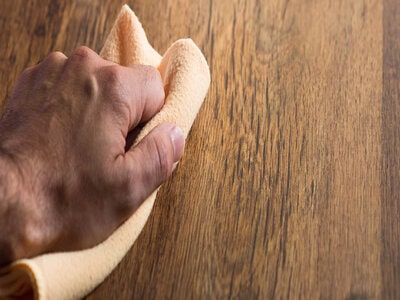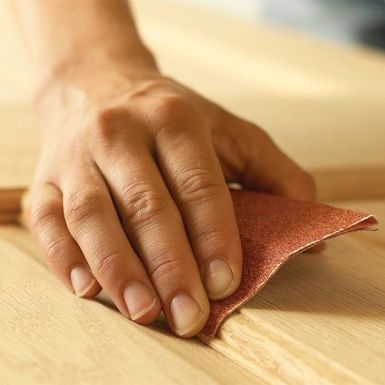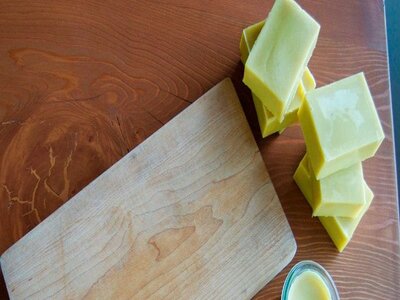How to Apply Beeswax to Wood [In 6 Easy Steps]
Our house needs constant maintenance especially as regards the furnishing elements, for example wooden furniture. There are several treatments to be used to keep the appearance of the wooden furniture always at its best. Among these we find beeswax. Let’s see together in more detail how to apply beeswax to wood.
How to Apply Beeswax to Wood Step by Step
What you need:
- Grinding machine / orbital sander
- Brush
- Triangle scraper
- Chisel / carving knife
- Duster
- Polishing fleece bonnet
- Beeswax
- Various grain sizes of sandpaper
- Cotton rag
Here are the steps to apply beeswax to wood:
Step 1:Remove residue from the wood surface

Any residue of old paint or dirt must be removed from the wood surface. In most cases, it is not sufficient to remove the old paint from a workpiece with a pickling agent or a hot air blower.
So that you can apply the beeswax correctly and the surface looks nice and even later, completely remove all paint, varnish, wax residues, polishes and any excess oil.
You are going to be as meticulous as possible. If necessary, you can use paint stripper, a spatula or a heat gun. For the subsequent cleaning, it is best to only use water, if necessary in conjunction with an intensive cleaner specially designed for wood.
Other cleaners or soap can attack the wood or have a negative effect on the waxing process. After cleaning, let the piece of furniture or the wooden surface dry well.
Here is a simple tutorial to help you remove paint from wood!
Step 2: Sand the wood surface before applying beeswax

You sand the wood surface with fine sandpaper before waxing . Then the wood will absorb the wax well later. You work evenly and don’t leave out any spots – only then will you get an even result.
A wafer-thin layer remains on the wood surface, which you may not be able to see, but which prevents the wax from being absorbed into the wood. Therefore, you should always sand down the piece of furniture as well.
The wood must be absorbent, but should still be sanded very smooth. In the final sanding step, sandpaper with a grit of 180 is well suited.
Fine grooves and filigree shapes are very carefully carved out with a carving knife. You can remove the old paint well with a triangle scraper on inner corners and strips.
This practical tool is also available in other very unusual shapes and angles, which are very suitable for working on antique pieces of wood.
Do you want to remove candle wax from wood? Here is an easy step by step guide to help you!
Step 3: Prepare the beeswax before applying it

The proportions . 100gr of beeswax, between 400-500 ml of turpentine (when the pore of the wood is open, a higher proportion of beeswax is used, therefore less amount of turpentine), 50 gr of carnauba wax.
Since the wax in its pure state is solid, it is necessary to heat it to make it liquid. For this, the beeswax is put in a water bath, approximately and depending on the amount 15-20 min at 75-100 degrees.
Without letting it cool, mix it with the turpentine and stir until it is a completely homogeneous compound. Now we will let it cool before applying.
Step 4: Apply the beeswax to wood
If you have used a cleaner with water, the wood should dry thoroughly before waxing. If possible, apply a solid beeswax with old cotton cloths. To do this, dab the wax very sparingly with the cotton rag. First of all, be a bit stingy and apply the beeswax to the wood in small circular movements.
When you apply the beeswax to wood, you should pay attention to not use too much or too little wax and work evenly with a soft, lint-free cloth or ball of fabric . You can then remove any remains with a rag or a coarser cloth.
Take the paste wax or finishing wax and spread the product evenly with a fiber cloth. In addition, avoid placing thick layers since when it dries it will not do it evenly. On the other hand, if you do it by controlling the step of the wrist in the direction of the beta, we will avoid unnecessary shadows.
Apply the paste or finishing wax in a smooth way, starting on one side and continuing to the other end, taking care that they are thin layers, leaving no room for it to dry, return and repeat the process with a second layer of beeswax.
Step 5: Wait for the beeswax to dry
Let the beeswax dry on wood from 20 minutes to 1 hour. Take into account that depending on the country and its climate, the drying time may take a little longer. For this reason, you can check if it is completely dry, touching the surface with the tip of a finger and it should not be sticky.
The dry wax also has to soak in for a while. Depending on how well the pores of the surface were opened during the preparatory work, the wax absorbs faster or slower in some wooden furniture. Be patient and wait between half an hour and an hour until the beeswax has absorbed sufficiently well.
Step 6: Reapply another layer of beeswax to wood
Raw wood usually needs more than one beeswax coating, so after the first drying phase you can start waxing again. A third round may also be necessary.
With solid waxes, it is seldom necessary to wax the furniture one more time. However, if you have used a paste or liquid wood wax, you may need to apply wax one more time after polishing.
But that also depends on the absorption capacity of the wood. In the case of restored old furniture, the absorption capacity is usually no longer particularly high. However, if you’ve made a great piece of furniture or a children’s toy from scratch from untreated wood, you’ll need to apply at least two layers of beeswax.
In turn, remove excess beeswax residue with a rag. Always note the time it takes for the wax to dry. Basically, you treat waxed wooden surfaces from time to time.
How to Apply Beeswax to Wooden Furniture
Your wooden furniture undergoes many tests every day in the face of stains, scratches and other consequences of daily use. Are you wondering how to protect it? We offer a tutorial to help you beeswax your wooden furniture with ease, allowing it to continue to look good without the fear of being damaged.
Here are the steps for applying beeswax to wooden furniture:
- First you have to clean the furniture to be treated well. If you have accumulated remains of dirt, it is best to start with a sanding of the entire surface. Remove the dust that will remain when sanding and continue.
- Make sure there are no traces of dust left and that the furniture is completely dry before applying the wax.
- Apply the wax with a cloth or cotton doll, do it in circular movements so that it penetrates well. Be generous in the application and if you see that the wood absorbs the wax, do not hesitate to apply another coat.
- Remove any excess wax that remains on the wood with a clean cloth. If you want your furniture to be more shiny, polish with a clean cloth in the direction of the wood grain.
- Let the furniture dry at least 24 hours before using it and you will have it ready.
Types of Waxes applied on Wood
| Types of Waxes applied on Wood | Description |
|---|---|
| 1. Beeswax | The most commonly used wax for handicrafts in wooden furniture is beeswax, also called virgin wax. However, not all beeswax are the same. They are distinguished by their qualities, purities, and colors: they can be white or yellow, with brown or reddish tones. The latter are used both to reinforce the effect of a dye , and to replace it. However, the wax that most enhances the tone of the wood is yellow. All of them are sold in blocks or loaves. |
| 2. Carnauba wax | This wax stands out for the shine it brings to surfaces. In addition, it is compatible with many other types of wax and provides great hardness and high wear resistance. It is often sold in bread and flake form. This type of wax is used when the original patina is well preserved. To do this, you have to mix it with beeswax, melt both and add essence of turpentine. |
Advantages and Disadvantages of Beeswax Finish on Wood
Natural . Forget about toxic or environmentally harmful chemical compounds. In fact this is a common finish in wooden toys for children that have been made by hand.
Easy to apply . This is a great advantage, that the application of beeswax on a piece of furniture is something quick and easy, it allows anyone to apply it without the need for a professional tool.
Economical. Not only the materials are inexpensive, the tool required for the application cannot be less.
It nourishes and protects the wood , although it obviously does not offer the levels of protection that other finishes offer.
Glossy finish. We can also vary the level of gloss depending on the number of layers and intensity of the polish.
It does not create a waterproof layer , thus allowing the wood to breathe. Although on the other hand it does not protect against stains caused by spilling some types of liquids.
Disadvantages
High maintenance . With time and use, dust and dirt accumulate more easily than in other finishes, which forces to reapply a new layer of beeswax with some frequency. Although on the other hand, as we have already pointed out, it is quite simple and fast to do.
Limited resistance . The resistance offered by a layer of beeswax is low. It grates quite easily.
Where to get beeswax?
You will easily find beeswax in nuggets or bread in organic stores or on online sales sites. If possible, prefer organic beeswax to be sure that no pesticide residue is present. You can also research if a beekeeper is near you to buy them for direct sale.
What is the purpose of wax in wood?
Waxes are used in the final part of the restoration of a piece of furniture, to improve the finish. In addition, they serve to give a soft and quality appearance to furniture, especially solid wood.
If I have a furniture already painted, can wax be applied to the furniture?
If it can be applied, just taking into account that in this case we recommend 2 types of wax, the transparent one and the colored one that fits the furniture that is being worked on.




